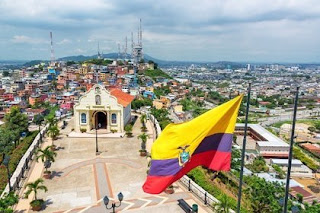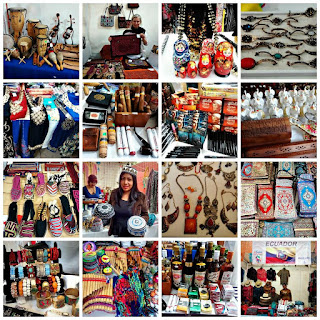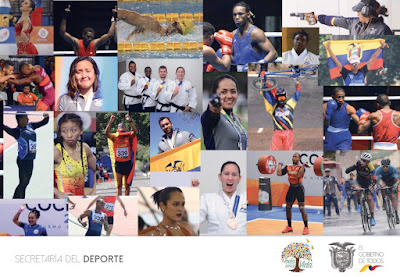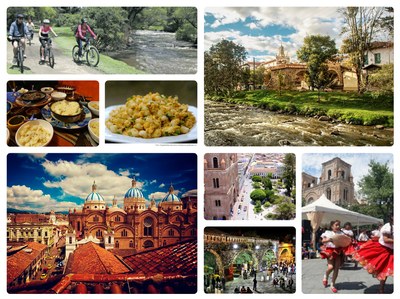Wonderful Ecuador Week #1 Third Term 2020-2021
WONDERFUL ECUADOR
1. LET'S PLAY WITH KAHOOT. HOW MUCH DO YOU KNOW ABOUT ECUADOR?
2. DISCUSS: WHAT ARE SOME INTERESTING FACTS YOU ALREADY KNOW ABOUT ECUADOR RELATED TO HISTORY, TECHNOLOGY, SCIENCE, AND ART? NAME AT LEAST ONE FOR EACH CATEGORY. SHARE YOUR ANSWERS WITH YOUR CLASSMATES OR FAMILY.
3. READ THE FOLLOWING TEXT.
Ecuador
The official name of our country is the Republic of Ecuador. It is the second smallest country in South America, with 256,370 square kilometers. Due to its position on the equator, our country has incredible biodiversity and wonderful landscapes. The official language is Spanish. Quichua is spoken by many indigenous nationalities. About ten other native languages are also official in their communities. According to the law, all indigenous languages in Ecuador must be respected and preserved. Ecuador uses the United States Dollar as its currency. The capital city is Quito.
4. BASED ON THE READING, WHICH SENTENCES ARE CORRECT?
a. Ecuador is the second largest country in South America.
b. We have great biodiversity because we are far from the equator.
c. About 12 languages are spoken in our country.
d. Approximately 24.1% of indigenous people live in the Amazonia. e. There are about 1.1 million indigenous people in Ecuador.
5. ANSWER THE QUESTION: What else do you know about different indigenous groups?. Write 2 shorts descriptions of 2 different indigenous groups in your own words.






The shuar have a second name as the jibaros live in the Ecuadorian Amazon, which is a very large population, their clothing is a blue skirt, a canvas of veritical lines of colors such as purple, red, black, and white are made of vegetables that They wrap around the waist and ankles, their typical dish is Ayampaco, which is made of green fish, eggs, tomato, onion, etc. The language they use is Shuar and Spanish, their traditional music is dance as it represents the Gerra, the marriage. and thanks to the land
ResponderEliminarEXERCISE 5
ResponderEliminar● Shuar culture :
They live between the jungles of Ecuador and Peru, their language is Spanish and Shuartuculo, their religion is Christianity, mostly Catholic and it is the most numerous Amazonian indigenous people of approximately 80,000 individuals, among the most typical dishes is Ayampaco, prepared with fish or chicken, hearts of palm and spices, wrapped in bijao leaves and roasted. Other representative foods are roast beef, yucca and palm heart tamale, fritters, yucca tortilla, sweaty meat.
●Quisapincha culture:
The San Antonio de Quisapincha parish is one of the oldest in the province of Tungurahua. On May 19, 1861, Quisapincha was elevated to the category of parish. It is a highly productive sector dedicated to the manufacture of leather garments. This rural parish is located to the southwest, 12 kilometers from Ambato. It has a temperate and cold climate and is one of the recognized places inside and outside the province.
● Chibuleo culture: The Chibuleo Indigenous People are located in the central highlands of Ecuador, belonging to the Kichwa Peoples and Nationalities of Ecuador,
ResponderEliminarThe origin of its name is due to a plant called Chibu that long before lived in this place and Leo comes from the descendants of the Panzaleo culture in the province of Tungurahua from which they originate.
The Chibuleo People are recognized at the National and International level for actively participating in the Indigenous Uprisings to claim their rights and to revoke the governments that have attacked the economic and social interests of Ecuadorians.
●Quisapincha culture: The San Antonio de Quisapincha Parish is the oldest in the Province of Tungurahua, Cantón Ambato, Ecuador. On May 19, 1861, Quisapincha was elevated to the category of parish. It is considered as a highly productive sector and dedicated to the manufacture of all kinds of clothing made of leather.
-Exercise 5
ResponderEliminar-NATIVE POPULANCE
They are among the most disadvantaged and vulnerable in the world. Although they are less than 5% of the world's population, indigenous people represent 15% of the poorest. They are more likely to suffer from malnutrition and generally lack adequate access to social protection systems and economic resources.
-Afro-Ecuadorians are an ethnic group that arose from the slavery of their African ancestors brought to Ecuadorian territory in the 16th century. ... Maintaining their rites, their gods and traditions allowed this ethnic group to continue and develop in a new habitat.
-The Tsáchila, also called Colorados, are an indigenous people that live in the province of Santo Domingo in Ecuador. Their language is Tsáfiqui, from the Barbacoan linguistic family, which means the true word.
NAME: JOSEPH CHADAN
EJERCICIO 5
ResponderEliminar1Saraguro culture
This ethnic group was never dominated and maintains the strength of its race and its customs. They are proud of their lineage, jealously guard their lineage and speak the purest Kichwa.
2Quisapincha culture
It is one of the most recognized places inside and outside the province for articles based on leather. Quisapincha has great tourist potential due to its natural settings suitable for ecotourism.
..Quisapincha culture
ResponderEliminarIt is one of the most recognized places inside and outside the province for articles based on leather. Quisapincha has great tourist potential due to its natural settings suitable for ecoturismo
.The origin of its name is due to a plant called Chibu that long before lived in this place and Leo comes from the descendants of the Panzaleo culture in the province of Tungurahua from which they originate.
Lisbeth Paste
EliminarRONNY QUINATOA
ResponderEliminarEJERCICIO 5
Es llamada "Capital Intercultural del Ecuador" por su riqueza cultural e histórica, y por ser el lugar de origen del pueblo quichua de los otavalos, famosos por su habilidad textil y comercial, características que han dado lugar al mercado artesanal indígena más grande de Sudamérica, llamado "La Plaza de Ponchos
panzaleo culture
This ancient indigenous culture initially occupied the territories located between Quito and Riobamba, and later - what Jacinto Jijón y Caamaño called "Civilización Panzaleo III" - also spread to the Amazon regions of Quijos, Archidona and Baeza.
They live between the jungles of Ecuador and Peru, their language is Spanish and Shuartuculo, their religion is Christianity, mostly Catholic and it is the most numerous Amazonian indigenous people of approximately 80,000 individuals, among the most typical dishes is Ayampaco, prepared with fish or chicken, hearts of palm and spices, wrapped in bijao leaves and roasted. Other representative foods are roast beef, yucca and palm heart tamale, fritters, yucca tortilla, sweaty mea
ResponderEliminarThe San Antonio de Quisapincha parish is one of the oldest in the province of Tungurahua. On May 19, 1861, Quisapincha was elevated to the category of parish. It is a highly productive sector dedicated to the manufacture of leather garments. This rural parish is located to the southwest, 12 kilometers from Ambato. It has a temperate and cold climate and is one of the recognized places inside and outside the province.
_Exercise 5
ResponderEliminar.Quisapincha cultures
The San Antonio de Quisapincha Parish is the oldest in the Province of Tungurahua, Canton Ambato, Ecuador. On May 19, 1861, Quisapincha was elevated to the category of parish. It is considered a highly productive sector and dedicated to the manufacture of all kinds of clothing made of leather. Quisapincha is the oldest settlement in Ambato. The Quisapinchas were owners of the land where the 'Garden City of Ecuador' is located, Ambato. ... The attitude of the colonizers caused "forced flight" of our ancestors from where Ambato is today to where Quisapincha is today. Quisapincha also has great tourist potential due to its natural settings suitable for ecotourism.
.Chinborazo cultures
The province of Chimborazo is one of the 24 provinces that make up the Republic of Ecuador, located in the south-central part of the country, in the geographical area known as the inter-Andean region or sierra, mainly on the Chambo basin in the northeast and the Chimbo and Chanchán in the southwest. Its administrative capital is the city of Riobamba, which is also its largest and most populated city. It occupies a territory of about 5,999 km², being the sixteenth province of the country by extension. It limits to the north with Tungurahua, to the south with Cañar, to the west with Bolívar, to the southwest with Guayas and to the east with Morona Santiago.
_Exercise 5
ResponderEliminarPURUHUA CULTURE:
Puruhá (300-1500 AD)
The Puruhá manor was a society settled in what is now the province of Chimborazo. They spoke the Purway language and had as tutelary gods the Tungurahua and Chimborazo volcanoes, they also worshiped the Sun and the Moon.
The men of this culture wore cotton or cabuya fiber T-shirts that reached the middle of the leg, while the women wore wool anacos. In both cases, the hair was kept long and braided, fastened with a cabochon headband.
Embroidered clothing was reserved only for the bosses and the richest people.
ACHUAR CULTURE: The Achuar are a tribe of 6,000 indigenous people who still live in their traditional ways, in small communities along the Ecuadorian and Peruvian border. The Achuar have been able to maintain their cultural identity in the face of progress and modernization, due to their remoteness and the difficulty of reaching their communities. Right now they are only accessible by chartered plane or a 10-day canoe ride! The Achuar lived without real contact with the outside world until the late 1960s, when missionaries began entering the territory.
NOMBRE ABIGAIL TOROSINA
ResponderEliminarQuisapincha is the oldest settlement in Ambato. The Quisapinchas were owners of the land where the 'Garden City of Ecuador' is today, Ambato. Their typical dish is composed of boiled las such as melloco, ocas, potatoes, broad beans, corn and cheese or map huira, this dish was enjoyed in The mingas of the Communities and their traditional clothing is made up of The traditional clothing of the quisapinchas men is a red poncho with black stripes and white pants while the women wear white embroidered blouses made by themselves and a black sheep wool skirt, with espadrilleThe Kisapimchas people are bilingual, they speak their mother language Kichwa and Spanish as a second language.The dance you practice is the folkloric ansestral dance
Zapara culture:
ResponderEliminarThey live east of the Pastaza province, to the south it borders Peru, their language is Zápara (also called Kayapwe) is a SOV language that belongs to the Zaparoana family. It is extinct in Ecuador and Peru, its religion is both Catholic and Evangelical, mostly Catholic, its inhabitants are 1,300 people, its most important vegetable has been palm hearts for a long time as well as fish and other fruits.
Quisapincha culture:
The San Antonio de Quisapincha parish is one of the oldest in the province of Tungurahua. On May 19, 1861, Quisapincha was elevated to the category of parish. It is a highly productive sector dedicated to the manufacture of leather garments. This rural parish is located to the southwest, 12 kilometers from Ambato. It has a temperate and cold climate and is one of the recognized places inside and outside the province.
the chibuleos
ResponderEliminarChibuleo is an indigenous Kichwa-speaking people, the ones that stand out from this town is that they maintain their clothing, their festivals and their trabisiones, as well as the use of their own musical instruments such as the pingullo, the lurker, the hunca, the horn and also among its most significant commemorations is The Inti Raymi is celebrated every year in honor of the Inti the Sun God and its typical dish is potatoes with guinea pig avitan as San Luis San Francisco
THE SARAGUROS
The saraguros their clothes are black wool poncho, belt made of leather, black pants that go up to the knee and the clothes of the woman is an embroidered skirt and a black shawl, white shirt embroidered in many colors and her tabision is the dance of the offerings the marriage and the saromwi their typical dish is quinoa soup they abitan in the province of loja
EzequielQuile
ResponderEliminar* Chibuleo :
The Chibuleo Indigenous People are located in the central highlands of Ecuador, belonging to the Kichwa Peoples and Nationalities of Ecuador,
The origin of its name is due to a plant called Chibu that long before lived in this place and Leo comes from the descendants of the Panzaleo culture in the province of Tungurahua from which they originate.
The Chibuleo People are recognized at the National and International level for actively participating in the Indigenous Uprisings to claim their rights and to revoke the governments that have attacked the economic and social interests of Ecuadorians.
*Quisapincha :
The San Antonio de Quisapincha Parish is the oldest in the Province of Tungurahua, Cantón Ambato, Ecuador. On May 19, 1861, Quisapincha was elevated to the category of parish. It is considered as a highly productive sector and dedicated to the manufacture of all kinds of clothing made of leather.
Ejercise 5
ResponderEliminar1.Quisapincha culture
It is one of the most recognized places inside and outside the province for articles based on leather. Quisapincha has great tourist potential due to its natural settings suitable for ecotourism
2.Saraguro culture
This ethnic group was never dominated and maintains the strength of its race and its customs. They are proud of their lineage, jealously guard their lineage and speak the purest Kichwa.
.Quisapincha culture
ResponderEliminarIt is one of the most recognized places inside and outside the province for articles based on leather. Quisapincha has great tourist potential due to its natural settings suitable for ecoturismo
.The origin of its name is due to a plant called Chibu that long before lived in this place and Leo comes from the descendants of the Panzaleo culture in the province of Tungurahua from which they originate.
2.Saraguro culture
This ethnic group was never dominated and maintains the strength of its race and its customs. They are proud of their lineage, jealously guard their lineage and speak the purest Kichwa.
.THE CHIBULEOS
ResponderEliminarChibuleo is an indigenous Kichwa-speaking people, the ones that stand out from this town is that they maintain their clothing, their festivals and their trabisiones, as well as the use of their own musical instruments such as the pingullo, the lurker, the hunca, the horn and also among its most significant commemorations is The Inti Raymi is celebrated every year in honor of the Inti the Sun God and its typical dish is potatoes with guinea pig avitan as San Luis San Francisco
THE SARAGUROS
The saraguros their clothes are black wool poncho, belt made of leather, black pants that go up to the knee and the clothes of the woman is an embroidered skirt and a black shawl, white shirt embroidered in many colors and her tabision is the dance of the offerings the marriage and the saromwi their typical dish is quinoa soup they abitan in the province of loja
----------------------------------------UNIDAD EDUCTIVA QUISAPINCHA--------------------------------------NAME: Ronald Guamán
ResponderEliminarCOURSE: 1ero d B.G.U. ´´A´´
DATE: 30/06/2021
THEME: WONDERFUL ECUADOR
5. ANSWER THE QUESTION: What else do you know about different indigenous groups?. Write 2 shorts descriptions of 2 different indigenous groups in your own words.
Quisapincha culture
It is one of the places recognized inside and outside the province, for the production and commercialization of articles based on cattle leather, such as: sweaters, wallets, boots, hats and gloves. Quisapincha also has great tourist potential due to its natural settings suitable for ecotourism.
Saraguro culture
The saraguros, were originally, mitimaes sent by the Inca Huayna Cápac when he undertook the conquest of Quito. This ethnic group was never dominated and maintains the strength of its race and its customs. They are proud of their lineage, jealously guard their lineage and speak the purest Kichwa.
Course:1ro B.G.U "A ".
ResponderEliminarTheme:WONDERFUL ECUADOR.
5. ANSWER THE QUESTION: What else do you know about different indigenous groups?. Write 2 shorts descriptions of 2 different indigenous groups in your own words.
2.Saraguro culture
This ethnic group was never dominated and maintains the strength of its race and its customs. They are proud of their lineage, jealously guard their lineage and speak the purest Kichwa.
▪︎Chibuleo culture: The Chibuleo Indigenous People are located in the central highlands of Ecuador, belonging to the Kichwa Peoples and Nationalities of Ecuador,
ResponderEliminarThe origin of its name is due to a plant called Chibu that long before lived in this place and Leo comes from the descendants of the Panzaleo culture in the province of Tungurahua from which they originate.
The Chibuleo People are recognized at the National and International level for actively participating in the Indigenous Uprisings to claim their rights and to revoke the governments that have attacked the economic and social interests of Ecuadorians.
▪︎Quisapincha culture: The San Antonio de Quisapincha Parish is the oldest in the Province of Tungurahua, Cantón Ambato, Ecuador. On May 19, 1861, Quisapincha was elevated to the category of parish. It is considered as a highly productive sector and dedicated to the manufacture of all kinds of clothing made of leather.
Shuar culture :
ResponderEliminarThey live between the jungles of Ecuador and Peru, their language is Spanish and Shuartuculo, their religion is Christianity, mostly Catholic and it is the most numerous Amazonian indigenous people of approximately 80,000 individuals, among the most typical dishes is Ayampaco, prepared with fish or chicken, hearts of palm and spices, wrapped in bijao leaves and roasted. Other representative foods are roast beef, yucca and palm heart tamale, fritters, yucca tortilla, sweaty meat.
Quisapincha culture:
The San Antonio de Quisapincha parish is one of the oldest in the province of Tungurahua. On May 19, 1861, .Quisapincha was elevated to the category of parish. It is a highly productive sector dedicated to the manufacture of leather garments. This rural parish is located to the southwest, 12 kilometers from Ambato. It has a temperate and cold climate and is one of the recognized places inside and outside the province.